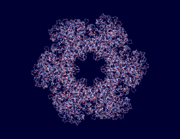Glutamine synthetase
From Proteopedia
| |||||||||
| 2gls, resolution 3.50Å () | |||||||||
|---|---|---|---|---|---|---|---|---|---|
| Ligands: | |||||||||
| Activity: | Glutamate--ammonia ligase, with EC number 6.3.1.2 | ||||||||
| |||||||||
| |||||||||
| |||||||||
| Resources: | FirstGlance, OCA, PDBsum, RCSB | ||||||||
| Coordinates: | save as pdb, mmCIF, xml | ||||||||
Contents |
Structure
An unrefined structure of glutamine synthetase is made of two layers, each containing 6 subunits, for a total of 12 subunits. [1] Each subunit contains an which is defined by a cylindrical shape formed by six antiparalel β starnds contributed by one subunit and two more strands by the neighbouring subunit. [1] In each cylindrical active site there are two Mn2+ ions: Mn 2+ 469 and 470. Both are attached to three protein chains and two water molecules, one of the water molecules are shared by both Mn2+. The protein ligands. Attached to Mn 2+ 469 is: Glu-131, GLu-212 and Glu-220, and the protein ligands attached to Mn 2+ are: Glu-129, His-269 and Glu-357.[1]
Unique to glutamine synthetase, unlike other enzymes, is it's "passive site". This refers to the central loop which is formed by a segment of the backbone that extends into the central aqueous cavity. [1]Unlike other sites in glutamine synthetase under the same conditions, this site is suceptible to proteolysis by four secreated proteases from the V8 protease of Staphylococcus aureus.[1]
Additional details in
User:Tom Gluick/Glutamine synthetase
User:Tom Gluick/Human Glutamine Synthetase
User:Tom Gluick/Human Glutamine Synthetase/Large Image Showing Signature with labels
User:Tom Gluick/Human Glutamine Synthetase/Quaternary Structure
User:Tom Gluick/glutamine synthetase
User:Adrian Aldrich/Prokaryotic Glutamine Synthetase Pfam Domains Outline
Classes
Glutamine synthetase has been described as having three destinctive types:[2]
- Class I (GSI): Genes for this class have only been found in bacteria (eubacteria) and archaea (arhaebacteria. The paper by Kumada et. al goes into detail on these two.[3]
- Class II (GSII): Genes for this class have only been found in eukaryotes and a few soil-dwelling bacteria.The paper by Kumada gets into further detail about these bacteria. [3]
- Class III (GSIII): Genes from this class have only been found in a few bacterial species.It is a hexamer of identical chains. It is much larger (about 700 amino acids) than the GSI (450 to 470 amino acids) or GSII (350 to 420 amino acids) enzymes. [2] Brown et. al.(1994) explain in their paper the idea that lateral gene transfer from archeal GSI may have happened and explain the gene mutation.[2]
Function
Glutamine synthetase (GS) is an essential enzyme in the cellular nitrogen metabolism and has been found to play a role in both ammonia assimilation and glutamine byosynthesis.[3] It is the only enzyme capable of glutamine synthesis and is required for the two step process synthesizing glutamate to glutamine. The glutamine produced is an essential precursor for purine and pyrimidine synthesis, a modulator of protein turnover or an intermediate for gluconeogenesis and acid-base balance. [4]
3D structures of glutamine synthetase
Updated on 27-August-2014
Glutamine synthetase
3ng0 – GS + phosphoaminophosphoric adenylate – synechocystis
3ogx – GS III – Bacterioides fragilis
3fky – GS - Escherichia coli
1htq - MtGS I – Mycobacterium tuberculosis
2uu7 – apo-GS – dog
Glutamine synthetase tertiary complex
2wgs, 2whi – MtGS I + inhibitor
2bvc - MtGS I + transition state analog
2qc8, 2ojw – GS + ADP + phosphate derivative – human
2d3a, 2d3c - mGS + ADP + phosphate derivative – maize
2d3b - mGS + AMPPNP + phosphate derivative
1f1h – StGS + ADP + Tl – Salmonella typhimurium
1fpy - StGS + ADP + phosphinothricin
Glutamine synthetase binary complex with nucleotide
1hto - MtGS I + AMP
1f52 - StGS + ADP
1lgr, 2lgs - StGS + AMP
2gls - StGS
References
- ↑ 1.0 1.1 1.2 1.3 1.4 Yamashita MM, Almassy RJ, Janson CA, Cascio D, Eisenberg D. Refined atomic model of glutamine synthetase at 3.5 A resolution. J Biol Chem. 1989 Oct 25;264(30):17681-90. PMID:2572586
- ↑ 2.0 2.1 2.2 Brown JR, Masuchi Y, Robb FT, Doolittle WF. Evolutionary relationships of bacterial and archaeal glutamine synthetase genes. J Mol Evol. 1994 Jun;38(6):566-76. PMID:7916055
- ↑ 3.0 3.1 3.2 Kumada Y, Benson DR, Hillemann D, Hosted TJ, Rochefort DA, Thompson CJ, Wohlleben W, Tateno Y. Evolution of the glutamine synthetase gene, one of the oldest existing and functioning genes. Proc Natl Acad Sci U S A. 1993 Apr 1;90(7):3009-13. PMID:8096645
- ↑ He,Youji, Hakvoort,Theodorus, B.M., Kohler,S.Eleonor, Vermeulen,Jacqueline L.M.,Rudi de Waart, D., Theije,Chiel de, Gabrie A.M. ten Have, Van Eijk,Hans M.H., Kunne,Cindy, Labruyere,Wilelmina T., Houten,Sander M., Sokolovic,Mika, Tuijter,Jan M., Deutz,Nicolaas E.P., and Lamers, Wouter H. Glutamine Synthetase in muscle is required for glutamine production druing fasting and extrahepatic ammonia detoxification. The American Society for Biochemistry and Molecular Biology, January 11, 2010
| Please do NOT make changes to this Sandbox until after April 23, 2010. Sandboxes 151-200 are reserved until then for use by the Chemistry 307 class at UNBC taught by Prof. Andrea Gorrell. |
Proteopedia Page Contributors and Editors (what is this?)
Michal Harel, Rhiannon Khela, David Canner, Andrea Gorrell, Alexander Berchansky, Jaime Prilusky


